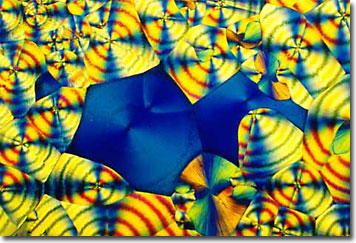Loes Modderman
Hydroquinone
Hydroquinone generally appears as an off-white powder or as fine, white, crystalline needles, and it is freely soluble in warm water or alcohol. Occurring naturally in some plants, this compound may also be formed by chemically reducing benzoquinone. Cooking grade oils, and fats often utilize this light, air-sensitive compound as a preserving agent.

|
View another digital image of recrystallized hydroquinone taken with the optical microscope. |
A familiar chemical in darkroom and laboratory settings, hydroquinone is an ingredient found in many photographic developers, and it is commonly used in processing black-and-white film. Industrial applications include its extensive utilization as an inhibitor or retardant in the production of plastics and rubber. Hydroquinone is also frequently employed as a chemical intermediate in the production of many dyes, varnishes, motor fuels, oils, and paints. In addition, the substance is an active ingredient in several dermatological drugs due to its antioxidant properties, and it is also used as a bleaching agent to slow melanin production in the treatment of hyperpigmentation.
Hydroquinone is generally produced in small volume through a complex process, and proper handling and precautions are required. The reduced form of hydroquinone is one of three isomers of dihydroxybenzene, which is chemically designated as p-dihydroxybenzene.
BACK TO LOES MODDERMAN GALLERY
